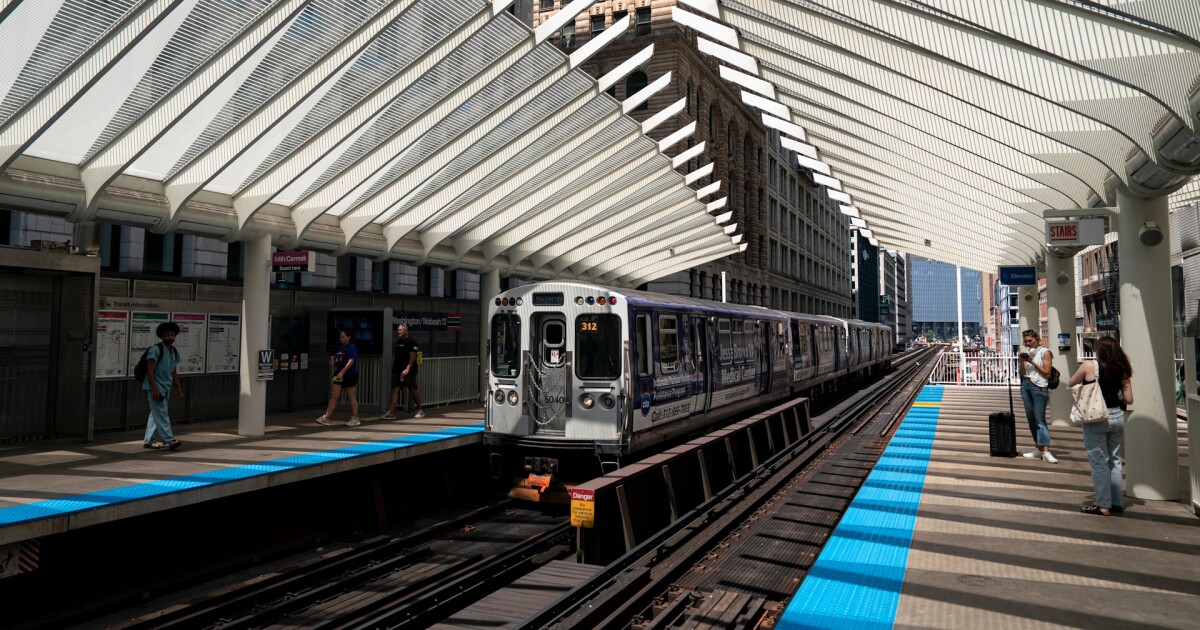How a sales tax law change delayed Chicago transit’s fiscal cliff
6 min read

Bloomberg News
A 2024 Illinois law changing sales tax distributions has ramifications for the fiscal cliff facing Chicago-area transit agencies.
Because of the three-month lag between when sales tax returns are filed and when distributions are made, the extent of the extra funding flowing to transit agencies did not become clear until recent months.
Transit agencies need the extra money. After a steep drop in ridership during the pandemic, farebox revenues have yet to recover to pre-pandemic levels, and federal pandemic relief funds will run out by early 2026.
The Chicago-area
Transit agency leaders have been negotiating with state lawmakers in Springfield. In late May, legislators
The effects of SB3362 could impact those negotiations. Among other things,
“The main difference would be that any local use rates, those transactions would (now) be based on the delivery address of the sales,” Maurice Scholten, president of the Taxpayers’ Federation of Illinois, told The Bond Buyer.
Online purchases are most affected
The law did not have a material impact on the state’s finances, but it impacts how tax revenue is distributed to and collected by local governments..
“There are going to be winners and losers; more winners, but some losers depending on the spending habits and online purchases of their residents,” Scholten said.
The 6.25% use tax is broken down into 5% for the state and 1.25% to be distributed to local governments on a per capita basis.
The ROT rate is still 6.25%, with the state still getting 5% and locals 1.25%.
“That 1.25% does get distributed differently, and that is now based on the location of the sale or the location where the item got delivered,” Scholten said. Another key change: “additionally, any locally imposed sales taxes will also be collected.”
The upshot is that more sales in the collar counties around Cook County and Chicago are covered by the RTA’s 0.75% sales tax, and more sales in Cook County are subject to its 1% sales tax for transit.
Scholten said it was known when the law passed that the change would be beneficial to many local political subdivisions, but the extent of the benefit only came into focus in April, when the first distributions from purchases made under the new law started coming in.
“We saw the impacts of increased revenue that RTA received, for example, in April of this year compared to April of last year, and it was significantly higher,” he said. “And every month thereafter has just kind of confirmed the overall trend of higher sales tax receipts.”
In 2025, nine of the 12 distributions will reflect the law change. In 2026, all 12 months will reflect the law change.
The new law has boosted RTA’s sales tax collections by $10 million per month, or $120 million for the year, according to
An RTA spokesperson said in an emailed statement that the RTA has formed a Fiscal Cliff Budget Task Force. It is led by RTA staff, with members from staff at CTA, Metra, and Pace.
Its goal is “to collectively develop funding forecasts and timelines,” according to the statement.
The RTA board is also mulling the creation of a Fiscal Cliff Ad Hoc Committee chaired by the RTA’s board chairman, Kirk Dillard. If approved by the RTA board, its first meeting would be Thursday.
“It’s hard to give a definitive answer,” Scholten said when asked if the extra revenue should change the amount RTA is seeking from state lawmakers. “With RTA’s budget, we understand that there’s a number of moving parts, different revenue sources. The sales tax is one of the sources, a significant revenue source for them, but I don’t have any insight into the expenditure side, how other revenue sources are doing.
“But the last four distributions that the RTA received, which correspond to sales made in the first four months of 2025, are 14% higher than the corresponding four months in 2024,” he said.
In a recent
“The RTA has now been aware of the bill since it became law in August 2024, and there are four months worth of tax data reflecting the law change,” he wrote in the Tribune, urging the RTA to offer new budget projections. “Continuing to rely on clearly outdated information does not build good intergovernmental faith nor public trust in this vital, regional economic engine.”
At its Thursday meeting, the RTA will discuss May’s financial results and some proposed legislation to address transit’s fiscal cliff, according
“We are committed to transparency and will share updated projections and public input opportunities as they become available,” the RTA said in the statement.
The agency noted that “$150 million represents approximately 6% of annual public funding for the RTA region and less than 4% of the annual RTA regional transit budget.”
S&P Global Ratings rates the RTA’s outstanding bonds AA with a stable outlook.
“If progress (is made) toward a timely and sufficiently sustainable funding solution for the RTA’s service boards, such as with an overestimated fiscal cliff due to recent changes in the sales tax collections in Illinois, leading to less pressure on the RTA and CTA and an improving overall creditworthiness, we could see positive credit implications,” Kenneth Biddison, an associate director at S&P, said by email.
“However, if a sufficient funding solution is not identified in a timely fashion, financial metrics will likely remain materially weaker than pre-pandemic levels, leading to a lower rating,” he added.
The rating agency said in a recent rating report that sales tax revenue had performed well even before the law change took effect, and noted the RTA region’s very strong economic fundamentals as well as the robust all-in maximum annual debt service coverage on the RTA’s bonds.
“We will be monitoring discussions within the RTA region and at the state level regarding progress towards a funding solution for transit,” including the possibility of a special session of the General Assembly, Biddison said.
The veto session in November and the beginning of the 2026 General Assembly next January are also opportunities for progress on transit, he said.
Moody’s Ratings
“The magnitude and scope of the fiscal cliff for various transit systems is a moving target and we are focused on the governance choices being made to make it past the fiscal cliff,” Hetty Chang, assistant managing director at Moody’s, said by email.
“Additional revenue streams based on ongoing reallocation of sales tax revenues is a positive, in that it identifies a recurring resource rather than a one-time stop gap,” she added.
Looking ahead, Chang said Moody’s is gauging the political appetite for supporting transit agencies with recurring, non-farebox revenues.
Scholten noted that with each passing month of data under the new law, the trend becomes clearer.
“It’s important for lawmakers to have all of the information in front of them when they are negotiating details of the additional revenues,” he told The Bond Buyer. “Hopefully RTA can update their numbers and update the revenue needed to avert the fiscal cliff.”
The RTA’s general obligation bonds are rated AA-plus by Fitch Ratings. The outlook is stable.
The RTA had about $1.1 billion of GO bonds outstanding as of March 1.







